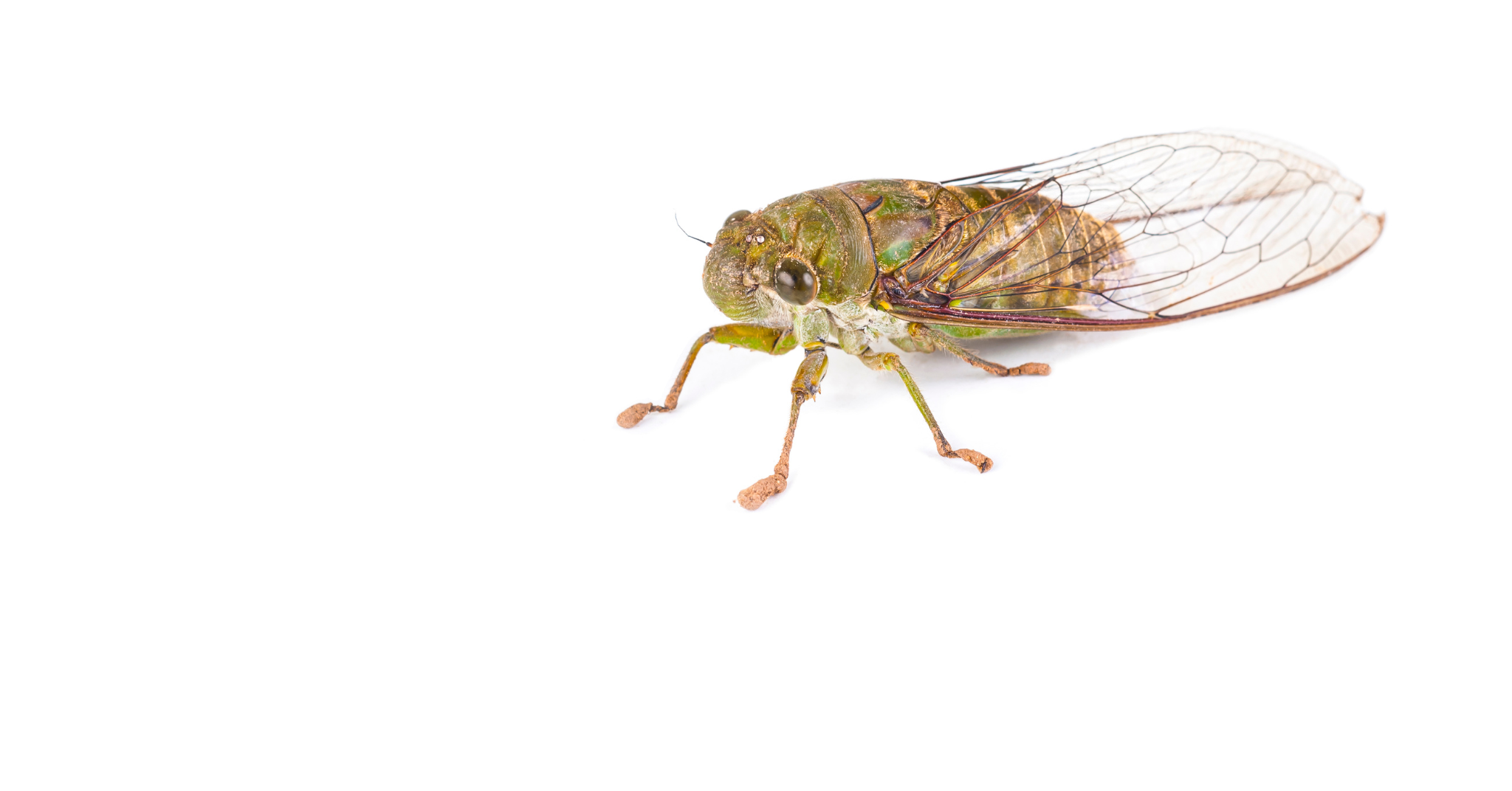What Do Cicadas Eat?

Cicadas are insects known for their loud, persistent calls during the summer months. While their distinctive songs may grab our attention, there’s more to these insects than meets the eye. For instance, what do cicadas actually eat? Cicadas are opportunistic feeders that feed on the sap from trees and other plants, but they also have unique feeding behaviors that set them apart from other insects.

WHAT DO CICADAS LOOK LIKE?
Let’s start with the basics: what are cicadas? What do they look like?
Cicadas are a type of insect belonging to the order Hemiptera and are known for their loud, distinct calls. They have distinctive features, including large, prominent eyes; transparent wings; and a robust body. Depending on the species, cicadas can range in size from 1.2–5.5 cm long.
They come in a variety of colors, including green, brown, and black, and their wings often have unique patterns or markings. In general, cicadas have a unique appearance that sets them apart from other insects and makes them easily recognizable.
In fact, there are several species of cicadas found in North America. Some of the most well-known include:
- Periodical Cicadas (Magicicada spp.): These cicadas are named after the periodical (or regular) cycles in which they emerge. They have a black body, red eyes, and orange-veined wings.
- Dog-day Cicadas (Neotibicen canicularis): These cicadas are named for the fact that they emerge during the hottest part of the year, in July and August. They have a green body with black markings and transparent wings.
- Annual Cicadas (Neotibicen spp.): These cicadas are also called summer cicadas and are seen more frequently than the periodical cicadas. They have a green body with brown markings and transparent wings with orange veins.
Overall, North American cicadas can range in size and color, but they all have similar body shapes, diets, and unique calling behaviors.

WHAT DO CICADAS NEED TO SURVIVE?
Cicadas are more than just the summertime soundtrack. They need several things to survive:
- Food: Cicadas feed on the sap from trees and other plants. The sap provides them with the necessary nutrients to survive and develop into adult insects.
- Shelter: Cicadas need a safe place to hide from predators, especially when they are in the nymph stage. The nymphs often burrow underground to avoid danger.
- Warmth: As cicadas are unable to regulate their own body temperature, they rely on external sources of heat to function properly. Without exposure to sunlight, cicadas would be unable to warm their bodies to the temperature required for flight and making noise.
- Water: As with all animals, cicadas also need access to water. They can obtain water from various sources, such as the sap from trees, dew, and rain.
- Mating Opportunities: Cicadas need to mate in order to reproduce and continue their species. They use their loud calls to attract mates and find each other.

WHY DO CICADAS LIVE UNDERGROUND?
Cicada larvae can stay underground for a long time. In fact, depending on the species, cicada nymphs can spend anywhere from 2–17 years underground, feeding on the roots of trees and developing into adult insects.
This extended period of time underground is known as the “brood period,” and it allows the cicadas to synchronize their emergence with optimal conditions for survival and reproduction.
After the brood period, the nymphs will emerge from the ground, shed their exoskeletons, and transform into adult cicadas.

CAN A CICADA HURT YOU?
In general, cicadas can’t hurt you. They are not poisonous and do not have any means to harm people. The worst that can happen is a cicada might accidentally fly or bump into you, but this isn’t likely to cause any harm.
While cicadas themselves do not pose a threat to humans, they can become a nuisance in large numbers, particularly when they emerge and infest trees. In extreme cases, heavy infestations of cicadas can cause extensive damage to young trees, shrubs, and other vegetation.

THE TOP BENEFITS OF GETTING RID OF CICADAS
If you’re dealing with a cicada infestation, it can be overwhelming and stressful, especially if you have young or vulnerable trees that are at risk of damage. Understanding the benefits of getting rid of cicadas can help you make informed decisions about how to manage cicada infestations and protect your property.
- Protect your trees: Cicadas can cause significant damage to trees, particularly young or vulnerable ones. By getting rid of cicadas, you can protect your trees from damage and ensure their continued growth and health.
- Reduce noise pollution: Cicadas are known for their loud and incessant buzzing, which can be a nuisance for many people. Getting rid of cicadas can help reduce noise pollution in your neighborhood.
- Improve quality of life: Cicadas can be a source of stress and anxiety for many people, particularly those who are sensitive to noise or have a fear of insects. By getting rid of cicadas, you can improve your quality of life and enjoy a more relaxed and comfortable living space.
If you’re dealing with a bothersome pest problem, don’t wait—reach out to Moxie Pest Control today for help! We’ll work with you to develop a customized pest control plan that meets your needs and protects your property.
SOURCES
- https://www.pestworld.org/pest-guide/occasional-invaders/periodical-cicadas/
- https://www.nwf.org/Educational-Resources/Wildlife-Guide/Invertebrates/Periodical-Cicadas
- https://academic.oup.com/biolinnean/article/135/2/291/6469331
- https://www.mdpi.com/1424-2818/5/2/166
- https://songsofinsects.com/cicadas/dog-day-cicada
- https://mdc.mo.gov/discover-nature/field-guide/annual-cicadas
- https://cicadas.uconn.edu/
- https://news.vanderbilt.edu/2011/05/19/cicadas-environmental-role/
- https://www.zobodat.at/pdf/DENISIA_0004_0455-0470.pdf
AUTHOR BIO
Courtney Enzor has worked in the pest control industry for about a decade. From helping you build a fly trap to giving you the best tips for identifying various bugs, she loves answering all your pest-related questions and sharing her pest-related expertise through writing. At the end of the day, she hopes her content will help people avoid mishaps and keep families happy and healthy!

